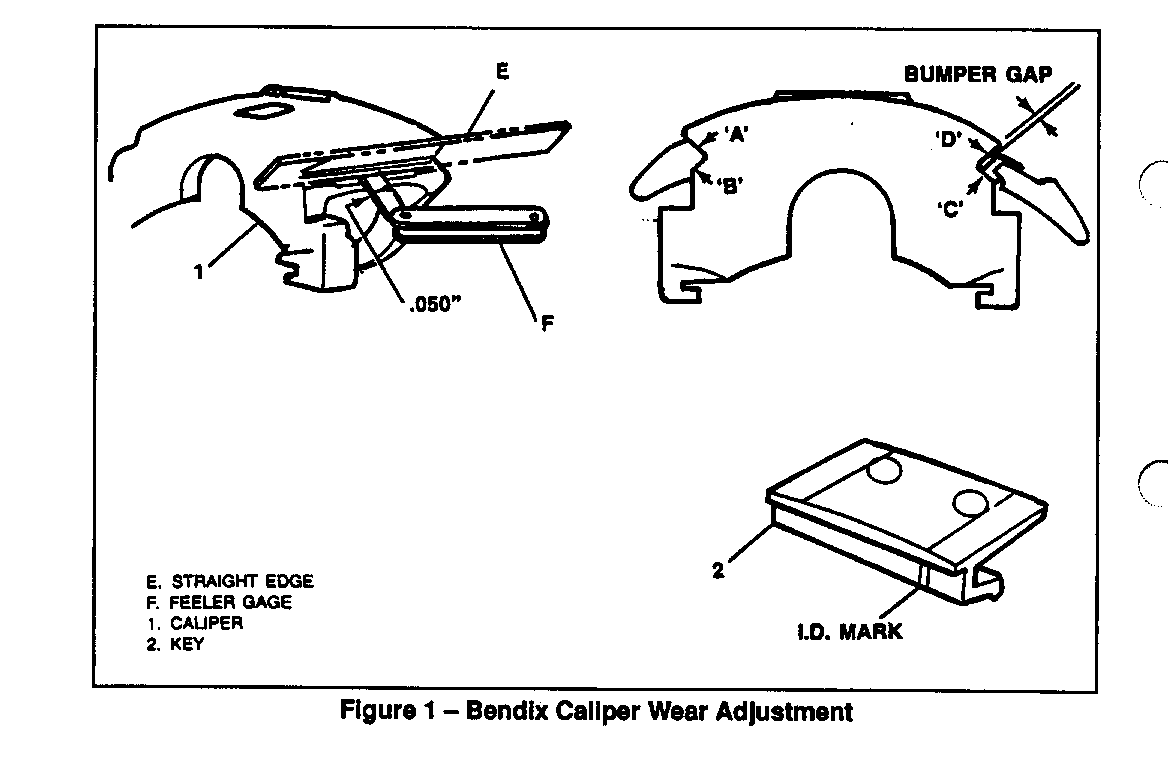SERVICE MANUAL UPDATE-SEC. 5A2 BENDIX BRAKE CALIPER WEAR ADJ.

SUBJECT: SECTION 5A2 - BENDIX BRAKE CALIPER WEAR ADJUSTMENT
VEHICLES AFFECTED: 1989-92 "C/K, R/V, G, P" TRUCKS WITH BENDIX CALIPERS
The following represents new information for section 5A2 in all C/K, G, P, R/V Model Service Manuals.
This information is in addition to the information found for front or rear disc brake service.
CALIPER AND STEERING KNUCKLE WEAR ADJUSTMENTS
Bendix brake calipers have oversize replacement keys available to compensate for wear at the caliper to steering knuckle/anchor plate contact points. The keys are identified by markings as indicated in figure 1. If wear is excessive, a rattle sound can be heard from the front brake area. Use the following procedure to measure and correct this condition.
Refer to figure 1.
1. Remove caliper. Refer to "Caliper."
o You do not need to disconnect the brake hose.
2. Clean surfaces A, B, C, and D with a wire brush.
3. Smooth any deep nicks and/or gouges with a file.
4. Measure caliper contact surface for wear.
A. Lay a straight edge across caliper surfaces "C" and "D."
B. Measure the maximum depth of any wear on these surfaces using feeler gages.
C. Calipers worn to a depth of 1.3 mm (0.050 inch) or more should be replaced.
5. Measure caliper to steering knuckle wear.
A. Install caliper back in steering knuckle.
B. Install a new standard size key without the spring.
C. Install the key retention bolt.
D. Insert a screwdriver into the center of the key bumper gap.
E. Pry firmly to ensure the caliper is seated at surfaces "A", "B", and "C."
F. Measure the bumper gap with the largest feeler gage(s) that will fit into the gap its full length.
G. Select a replacement key according to the following table.
Bumper Gap Replacement Kit ---------- --------------- 0.00 - 1.52 mm 0.000 - 0.060 inch Std. Size - 1 1.53 - 2.54 mm 0.061 - 0.100 inch 0.040 Oversize - 11 2.55 - 3.56 mm 0.101 - 0.140 inch 0.080 Oversize - 111 3.57 - 4.57 mm 0.141 - 0.180 inch 0. 1 20 Oversize - 1111 4.58 - 5.59 mm 0.181 - 0.220 inch 0.160 Oversize - 11111 5.60 mm - 0.221 inch - Replace Caliper and Anchor Plate or Steering Knuckle
6. Install caliper. Refer to "Caliper."

General Motors bulletins are intended for use by professional technicians, not a "do-it-yourselfer". They are written to inform those technicians of conditions that may occur on some vehicles, or to provide information that could assist in the proper service of a vehicle. Properly trained technicians have the equipment, tools, safety instructions and know-how to do a job properly and safely. If a condition is described, do not assume that the bulletin applies to your vehicle, or that your vehicle will have that condition. See a General Motors dealer servicing your brand of General Motors vehicle for information on whether your vehicle may benefit from the information.
